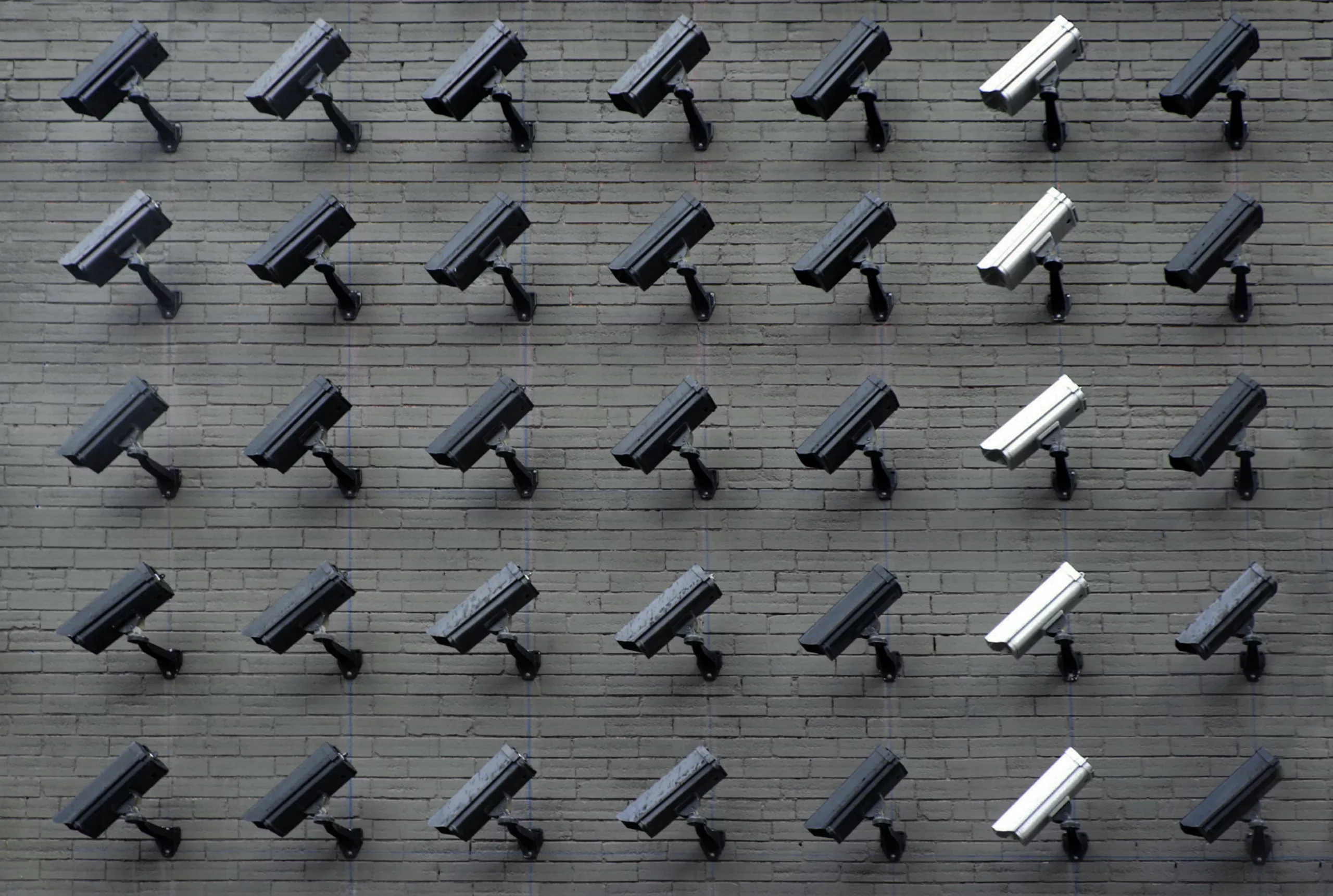Newsletter
Abolition Means No Digital Prisons
In this excerpt formerly incarcerated writer James Kilgore denounces the growing use of e-carceration technologies like ankle monitors.

In this excerpt from Colin Kaepernick’s Abolition for the People: The Movement For a Future without Policing and Prisons, formerly incarcerated writer James Kilgore denounces the growing use of e-carceration technologies like ankle monitors, facial recognition, and risk assessment.
On my second day home from prison, a cheery middle-aged white woman from the Illinois Department of Corrections showed up and locked an electronic monitor (EM) around my left leg. “Your parole agent will tell you the rules,” she informed me. “Until then, you are on lockdown.”
The agent phoned the next morning and told me I would be allowed out of the house Monday through Friday from 6 a.m. to 10 a.m. “You should be able to complete all your business in those hours,” he assured me. Those sunset walks and restaurant dinners with my family that I had dreamed of for six years suddenly turned into setting the alarm for 5:30 a.m. to use my full four hours of movement before the e-lock on the cage of our house clicked shut.
I spent a year on the monitor. Eventually they loosened my restrictions, but I still couldn’t leave the house without advance permission. In fact, I had to submit a list of all my movements two weeks at a time, leaving no room for spontaneity or emergencies. When I told people how frustrating life on the monitor was, they all had the same reply: “It’s better than prison.” They were missing the point. I wasn’t free, I had moved to e-carceration.
Fast forward ten years and a mass movement has arisen to get people out from behind the walls. Many of us are talking about prison abolition. Formerly incarcerated people have come together to form organizations like All of Us or None and the National Council for Incarcerated and Formerly Incarcerated Women and Girls. In response, authorities across the country are offering to release people on monitors as a “solution” to mass incarceration. In Chicago, and the state of Massachusetts, the use of monitors is skyrocketing. Though data is scarce, the number of people on monitors has risen from 55,000 in 2005 to an estimated 250,000+ in 2019. BI, the largest electronic monitoring company in the US, a subsidiary of the world’s largest private prison operator, the GEO Group, has secured its third five-year contract with US Immigration and Customs Enforcement (ICE) to place thousands awaiting adjudication of an immigration case on a GPS tracker. The deals have brought over six hundred million dollars to the company.
Despite the growth of monitors, the “better than prison” trope is losing ground. In a 2017 interview with me, Johnny Page, who was given electronic monitoring after twenty-three years in prison, offered a typical analysis, “You get to pay your own bills, you don’t have to wait in line for the telephone, you don’t have to wait in line for the shower, but you’re still in jail. It’s just another form of incarceration.”
Survivors of the shackle are fighting back. In Alameda, California, Robert Jackson and three plaintiffs launched a lawsuit against LCA, an EM company that forced them to pay $250 a week to be on the device. Jackson had landed on the monitor as part of a mercy release when his wife suddenly died of meningitis while he was serving 120 days in the county jail. The EM fees, plus feeding his three kids, quickly sunk him into debt. He lost his car and his apartment, and had to send his children out to stay with relatives. Currently, the suit is dragging through the courts.
Apart from individual litigation cases, there is organized resistance. Community Justice Exchange, a national network of more than 100 local bail funds, has pushed back against electronic monitors and is fighting for the freedom of people awaiting trial. In 2019 MediaJustice’s Challenging E-Carceration project joined with other nonprofits and people who had experienced EM to craft a law to ban the use of monitors on people released from prison in Illinois. The bill passed the House but COVID-19 intervened before it could reach the Senate. The resistance to what we are now calling ankle shackles continues to grow.
Those fighting for criminal justice reform as well as abolitionists have discovered that these devices don’t create alternatives or offer any dimension of freedom. They are extending and redefining our understanding of prison and incarceration. Monica Cosby, who spent twenty years in prison before landing on a monitor, described the situation, “any residence where you are living while on a monitor becomes like a satellite prison.” For many Black people the ankle band also triggers historical memories. Jean-Pierre Shackelford, who was on an ankle monitor for nearly three years in Ohio, reflected “when you think about it, it’s nothing but twenty-first-century slavery and control, electronic style.”
But e-carceration is not just about ankle shackles. While shackles are the most common form of e-carceration, phone apps are on the rise. A number of companies have jumped into this market. Predictably, BI is at the cutting edge with SmartLINK, which not only does GPS location tracking but can monitor respiration rate and heart rate while incorporating voice and facial recognition for log in. Since developing apps requires far less capital investment than producing shackles, startups like Acivilate, Outreach SmartPhone, and Guardian by Telmate are scrambling to secure contracts with local jails and state departments of corrections. Promise, a company funded by Jay-Z and Roc Nation, offers a similar app, one which founder and CEO Phaedra Ellis-Lamkins suggested would provide “‘liberty and justice for all’ to millions.” Her language of caring and patriotism provides cover for what abolitionists label carceral humanism, the marketing of tracking and controlling as a service rather than punishment.
Once ankle shackles developed GPS capacity, they became part of the surveillance state. Location tracking doesn’t just supply information to parole agents or courts. It ends up in the cloud, central control for racial capitalism. Dominated by Big Data giants, including Amazon, Microsoft, and Google, these megastorage sites create databases that house everything from GPS tracking details to criminal history to credit scores and school disciplinary reports. Processed via racialized algorithms, the data on the cloud target the criminalized sector of the population—a population that is disproportionately Black, Latinx, Indigenous, LGBTQ+, and poor that land in prisons, jails, and on ankle shackles. They are the vulnerable surplus of a rapidly diminishing employed working class.
Big Tech also markets this data, facilitating the systematic exclusion of the criminalized from housing, education, jobs, programs, and services. We find the cutting edge of this e-carceration in the Intensive Supervision Appearance Program (ISAP) run by ICE. Here the tracking data from individual migrants on ankle shackles blends with the data of millions in the ICE database, tracking their social networks, linking their organizing efforts, and monitoring their usage of state-funded services.
Abolitionists must call out the technologies of e-carceration—ankle shackles, facial recognition, risk assessment—along with the racist algorithmic formulas that target and punish the criminalized. We must call for technologies of liberation that open new opportunities, not technologies that confine us to our houses and neighborhoods with geo-fences. Rather than accommodate new forms of punitive data gathering, we must build on the existing efforts of activists and grassroots organizations to apply technology to the systemic problems of inequality and environmental destruction that are endemic to racial capitalism. These technologies of liberation will not come from Jeff Bezos or Bill Gates but must arise from the struggles and organizations that emerge as we carry the struggle for abolition forward.
(c) James Kilgore. Used by permission of the author and the publishers. From Abolition for the People: The Movement For a Future without Policing and Prisons, ed. Colin Kaepernick (Chicago: Haymarket Books, in cooperation with Kaepernick Publishing, 2023).

ICYMI—From The Appeal
A promising court diversion program in Milwaukee has been told it can continue serving clients while it fights the city’s move to cancel its contract without public explanation.
In the News
Police in Sauk Village, Illinois, tased and shot a 14-year-old boy with special needs after they stopped him on suspicion of damaging a window in March 2022. Body camera footage obtained by CBS Chicago showed an officer shot the boy in the back of his hip as he ran. The Cook County State’s Attorney and the Sauk Village Police Department have not filed charges or disciplinary measures against the officers involved, but the boy’s family filed a lawsuit against the department this month. [CBS Chicago]
Police in Texas arrested an 11-year-old child and put him in solitary confinement for three days after another student claimed the child had threatened their principal. [Josephine Lee / Texas Observer]
Pennsylvania jails failed to report nearly two dozen deaths last year according to an investigation by PennLive and the Pittsburgh Institute for Nonprofit Journalism. At least 65 people died in jail statewide in 2022, but jail officials only reported 40 deaths as requied by state law. Some jails skirted reporting requirements by releasing people with fatal illnesses or injuries before their death. [Joshua Vaughn & Brittany Hailer / PennLive & Pittsburgh Institute for Nonprofit Journalism]
Louisiana’s governor-elect wants to withhold funds for New Orleans’ decaying water infrastructure until women who seek abortions are prosecuted. [Gabrielle Perry / Essence]
Prosecutors charged a woman in Ohio with abuse of a corpse after she miscarried at 22 weeks. A forensic pathologist said the autopsy found no injury to the fetus and that the fetus had died before passing through the birth canal. [Nadine Grimley / WKBN]
Last week, The Sentencing Project released a report detailing reforms that state and local youth justice systems can and should adopt to combat the overuse of incarceration and maximize the success of youth who are placed in alternative-to-incarceration programs.” [The Sentencing Project]
City officials in Durham, North Carolina expanded the city’s mental health crisis response services last month. The program sends social workers or peer support specialists to certain behavioral health calls instead of police. [Sharryse Piggott / WUNC]
Unsealed surveillance videos show Los Angeles County Sheriff’s Deputies repeatedly committing violence against people in the county’s jails. In one video, deputies repeatedly punch a man in the head. In another, deputies slam a man’s head into a wall. [Keri Blakinger and Maria La Ganga / Los Angeles Times]
The NYPD is using police drones to film hundreds of protesters and handing the footage over to prosecutors to “help enhance arrests.” [Bahar Ostadan / Gothamist]
